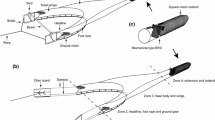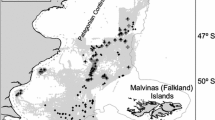Abstract
Effective mitigation measures were developed to reduce high levels of seabird mortality due to warp strikes in southern hemisphere trawl fisheries. However, in northern hemisphere trawl fisheries, little is known about the extent of cable strike seabird mortality or techniques to mitigate it. We compared the rate of heavy seabird strikes by third-wire cables and warps, using three mitigation measures compared to a control of no mitigation. Experiments were conducted aboard two catcher-processor vessels targeting walleye pollock (Theragra chalcogramma) in the eastern Bering Sea: one that rendered offal into fish meal and fish oil (Vessel R) and one that minced offal prior to discharge (Vessel M). More birds attended Vessel M, but the rate of seabird cable strikes was higher on Vessel R due to the greater aerial extent of its cables. Streamer lines significantly reduced heavy seabird strikes by both cable types regardless of discharge characteristics. Reducing the aerial extent of third wires also reduced third-wire strike rates, but this method was less effective than streamer lines. Warp booms designed to divert seabirds from warps failed to reduce seabird warp strikes, but this technique could be improved. These results show for the first time that seabird strikes with modern third-wire trawl sonar cable systems can be reduced through mitigation or gear modification and that warp strikes can be mitigated with techniques similar to those found successful in southern hemisphere fisheries. Mitigation measures and concepts identified in this study should be widely applicable.


Similar content being viewed by others
References
Abraham ER, Pierre JP, Middleton DAJ, Cleal J, Walker NA, Waugh SM (2009) Effectiveness of fish waste management strategies in reducing seabird attendance at a trawl vessel. Fish Res 95:210–219
Agretsi A (2002) Categorical data analysis, 2nd edn. Wiley, New York
Bartle JA (1991) Incidental capture of seabirds in the New Zealand subantarctic squid trawl fishery, 1990. Bird Conserv Int 1:351–359
Brothers NP, Cooper J, Lökkeborg S (1999) The incidental catch of seabirds by longline fisheries: worldwide review and technical guidelines for mitigation. FAO Fisheries Circular No. 937, FAO, Rome
Bull LS (2009) New mitigation measures reducing seabird by-catch in trawl fisheries. Fish Fish 10:408–427
CCAMLR (2006) Report of the twenty-fifth meeting of the Scientific Committee (SC-CAMLR-XXV). Annex 5, Appendix D. Commission for the Conservation of Antarctic Marine Living Resources, Hobart
Dietrich KS, Melvin EF (2007) Alaska trawl fisheries: potential interactions with North Pacific Albatrosses. WSG-TR-01. Washington Sea Grant, Seattle
FAO (2008) Report of the expert consultation on best practice technical guidelines for IPOA/NPOA—Seabirds. Bergen Norway, 2–5 September 2008. FAO Fisheries and Aquaculture Report. No. 880, Rome, 37p
Fitzgerald SM, Perez MA, Rivera KS (2008) Summary of seabird bycatch in Alaskan groundfish fisheries, 1993 through 2006. In: Boldt J (ed) Ecosystem considerations 2009. Appendix C of the Bering Sea/Aleutian Islands and Gulf of Alaska Groundfish Stock Assessment and Fishery Evaluation Report. North Pacific Fishery Management Council, 605 W 4th Ave., Suite 306, Anchorage, AK 99501, pp 116–141
Gonzalez-Zevallos D, Yorio P, Caille G (2007) Seabird mortality at trawler warps and a proposed mitigation measure: a case of study in Golfo San Jorge, Patagonia, Argentina. Biol Conserv 136:108–116
Højsgaard S, Halekoh U (2006) Quasi likelihood. http://gbi.agrsci.dk/statistics/courses/phd06/material/Day9-overdispersionQuasiLikelihood/handout-quasilik.pdf. Accessed 21 Nov 2006
IUCN (2009) 2009 Red list of endangered species
Labunski EA, Kuletz KJ (2004) Guide to the seabird observer notes database: a summary of NMFS groundfish fishery observer notes on seabirds. U. S. Fish and Wildlife Service unpublished report, Anchorage, AK
Melvin EF, Parrish JK, Dietrich KS, Hamel OS (2001) Solutions to seabird bycatch in Alaska’s demersal longline fisheries. Project A/FP-7, WSG-AS 01-01, Washington Sea Grant
Melvin EF, Dietrich KS, Thomas T (2004) Pilot tests of techniques to mitigate seabird interactions with catcher processor vessels in the Bering Sea pollock trawl fishery: final report. Final Report WSG-AS 05-05, Washington Sea Grant, University of Washington
NPPSD (2005) North Pacific pelagic seabird database, V1.0. US Geological Survey, Alaska Science Center & U.S. Fish and Wildlife Service, Anchorage, AK. http://www.absc.usgs.gov/research/NPPSD/
Ona E, Eger K (1987) Sonar observations of trawl performance. International Symposium on Fisheries Acoustic, June 22–26, Seattle, Washington, USA, No. 99, pp 1–10
Parish BB (1959) Midwater trawls and their operation. In: Kristjonsson H (ed) Modern fishing gear of the world. Fishing News (Books) Ltd, London, pp 333–343
Scharfe J (rapporteur) (1971) Discussion: instrumentation for trawl control. In: Kristjonsson H (ed) Modern fishing gear of the world: 3, Fishing News (Books) Ltd., Surrey, England, pp 405–410
Sullivan BJ, Brickle P, Reid TA, Bone DG, Middleton DAJ (2006a) Mitigation of seabird mortality on factory trawlers: trials of three devices to reduce warp cable strikes. Polar Biol 29:745–753
Sullivan BJ, Reid TA, Bugoni L (2006b) Seabird mortality on factory trawlers in the Falkland Islands and beyond. Biol Conserv 131:495–504
Thompson LA (2007) S_PLUS (and R) manual to accompany Agresti’s categorical data analysis (2002), 2nd edn. https://home.comcast.net/~lthompson221/Splusdiscrete2.pdf. Accessed 19 April 2007
USFWS (2003) Biological opinion on the effects of the total allowable catch (TAC)- setting process for the Gulf of Alaska (GOA) and Bering Sea/Aleutian Islands (BSAI) groundfish fisheries to the endangered short-tailed albatross (Phoebastria albatrus) and threatened Steller’s eider (Polysticta stelleri). U.S. Fish and Wildlife Service, Anchorage, AK
Watkins BP, Petersen SL, Ryan PG (2008) Interactions between seabirds and deep-water hake trawl gear: an assessment of impacts in South African waters. Anim Conserv 11:247–254
Weimerskirch HD, Capdeville D, Duhamel G (2000) Factors affecting the number and mortality of seabirds attending trawlers and long-liners in the Kerguelen area. Polar Biol 23:236–249
Zador SG, Parrish JK, Punt AE, Burke JL, Fitzgerald SF (2008) Determining spatial and temporal overlap of an endangered seabird with a large commercial trawl fishery. Endang Species Res 5:103–115
Acknowledgments
This research was funded in part by a grant from the U.S. Fish and Wildlife Service (Agreement 701813J541) and from Washington Sea Grant, University of Washington, pursuant to National Oceanic and Atmospheric Administration Award No NA04OAR4170032, Project A/F-6. The views expressed herein are those of the author(s) and do not necessarily reflect the views of NOAA or any of its sub-agencies. NOAA’s National Cooperative Research Program provided funding to retrofit two vessels with mitigation equipment. The Pollock Conservation Cooperative instigated this research, and Glacier Fish Company and American Seafoods Company hosted this research aboard their vessels and provided full cooperation at every stage. Ed Melvin, Stephani Holzwarth, Ben Starkhouse, Shannon Fitzgerald, Jeff Pesta, and Chris Thompson collected data at sea. Michelle Wainstein provided logistical support. Captain Tim Thomas provided a host of ideas for the development of mitigation measures tested in this study. Reviews by Richard Draves, Taina Honkalehto, Howard McElderry, Ed Richardson, Craig Rose, Ben Sullivan, and an anonymous reviewer improved the manuscript.
Author information
Authors and Affiliations
Corresponding author
Rights and permissions
About this article
Cite this article
Melvin, E.F., Dietrich, K.S., Fitzgerald, S. et al. Reducing seabird strikes with trawl cables in the pollock catcher-processor fleet in the eastern Bering Sea. Polar Biol 34, 215–226 (2011). https://doi.org/10.1007/s00300-010-0873-1
Received:
Revised:
Accepted:
Published:
Issue Date:
DOI: https://doi.org/10.1007/s00300-010-0873-1




